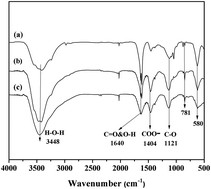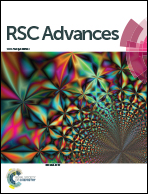Effect of porous zinc–biochar nanocomposites on Cr(vi) adsorption from aqueous solution
Abstract
A new synthesis method was developed to produce zinc–biochar nanocomposites from sugarcane bagasse. The modified biochar maintained 1.2 to 2.0 times higher removal efficiency than that of pristine biochar. FTIR, XPS, BET and SEM were used to analyse the physical and chemical properties of the composite adsorbent. Batch sorption experiments were carried out to investigate the adsorption behavior of Cr(VI) by zinc–biochar. Experimental data were better fitted by a pseudo-second-order kinetics equation and the Freundlich isotherm model. Thermodynamic analysis indicated that the adsorption process was spontaneous and endothermic. The maximum adsorption of the modified biochar was observed at pH 2.0 with the sorption capacity of 102.66 mg g−1. The adsorbed zinc–biochar could be effectively regenerated by 0.5 mol L−1 NaOH solution and the adsorption ability decreased from 84.16 to 59.75 mg g−1 in the sixth cycle. In conclusion, the porous zinc–biochar showed great potential advantages in the removal of Cr(VI) from wastewater.

- This article is part of the themed collection: Removal of chromium from aqueous solutions

 Please wait while we load your content...
Please wait while we load your content...